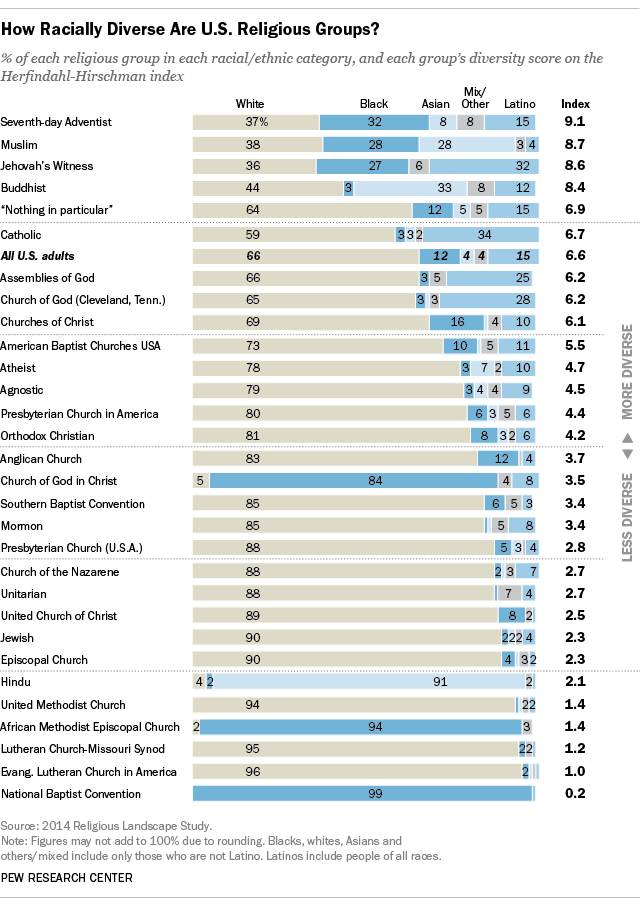The nation’s population is growing more racially and ethnically diverse – and so are many of its religious groups, both at the congregational level and among broader Christian traditions. But a new analysis of data from the 2014 Religious Landscape Study also finds that these levels of diversity vary widely within U.S. religious groups.
We looked at 30 groups – including Protestant denominations, other religious groups and three subsets of people who are religiously unaffiliated – based on a methodology used in our 2014 Pew Research Center report on global religious diversity. This analysis includes five racial and ethnic groups: Hispanics, as well as non-Hispanic whites, blacks, Asians and an umbrella category of other races and mixed-race Americans.

If a religious group had exactly equal shares of each of the five racial and ethnic groups (20% each), it would get a 10.0 on the index; a religious group made up entirely of one racial group would get a 0.0. By comparison, U.S. adults overall rate at 6.6 on the scale. And indeed, the purpose of this scale is to compare groups to each other, not to point to any ideal standard of diversity.
Seventh-day Adventists top the list with a score of 9.1: 37% of adults who identify as Seventh-day Adventists are white, while 32% are black, 15% are Hispanic, 8% are Asian and another 8% are another race or mixed race.
Muslims (8.7) and Jehovah’s Witnesses (8.6) are close behind in terms of diversity, as no racial or ethnic group makes up more than 40% of either group. Blacks, whites (including some people of North African or Middle Eastern descent) and Asians each make up a quarter or more of U.S. Muslims, while blacks, whites and Latinos each make up a quarter or more of Jehovah’s Witnesses.
Buddhists also rank high (8.4) on this measure of racial and ethnic diversity based on the 2014 Religious Landscape Study. But this group may be less diverse because Asian-American Buddhists may have been underrepresented since the survey was conducted in only English and Spanish, and not in any Asian languages.
Catholics and members of the Pentecostal denominations Assemblies of God and Church of God (Cleveland, Tenn.) both rank between 6.0 and 7.0 on the scale – comparable to U.S. adults overall – largely because of sizable Hispanic minorities. Roughly six-in-ten U.S. Catholics (59%) are white, while 34% are Hispanic; a quarter of the Pentecostal groups are Hispanic.
Among people with no religious affiliation, those whose religion is “nothing in particular” (score of 6.9 on the index) are more diverse than atheists (4.7) and agnostics (4.5). Most who describe their religion as “nothing in particular” are white (64%), but 15% are Latino, 12% are black, 5% are Asian and another 5% are something else or mixed race. By contrast, roughly eight-in-ten atheists (78%) and agnostics (79%) are white.
Although U.S. Jews (90% white) and Hindus (91% Asian) are not very diverse, especially compared with Americans overall, the five least diverse groups in the index are all Protestant denominations.
Members of the Evangelical Lutheran Church in America (a mainline denomination), the Lutheran Church-Missouri Synod (an evangelical denomination) and the United Methodist Church (the largest mainline church) are all more than 90% white. Meanwhile, two of the largest historically black Protestant denominations, the National Baptist Convention and the African Methodist Episcopal Church, have almost exclusively black members.
